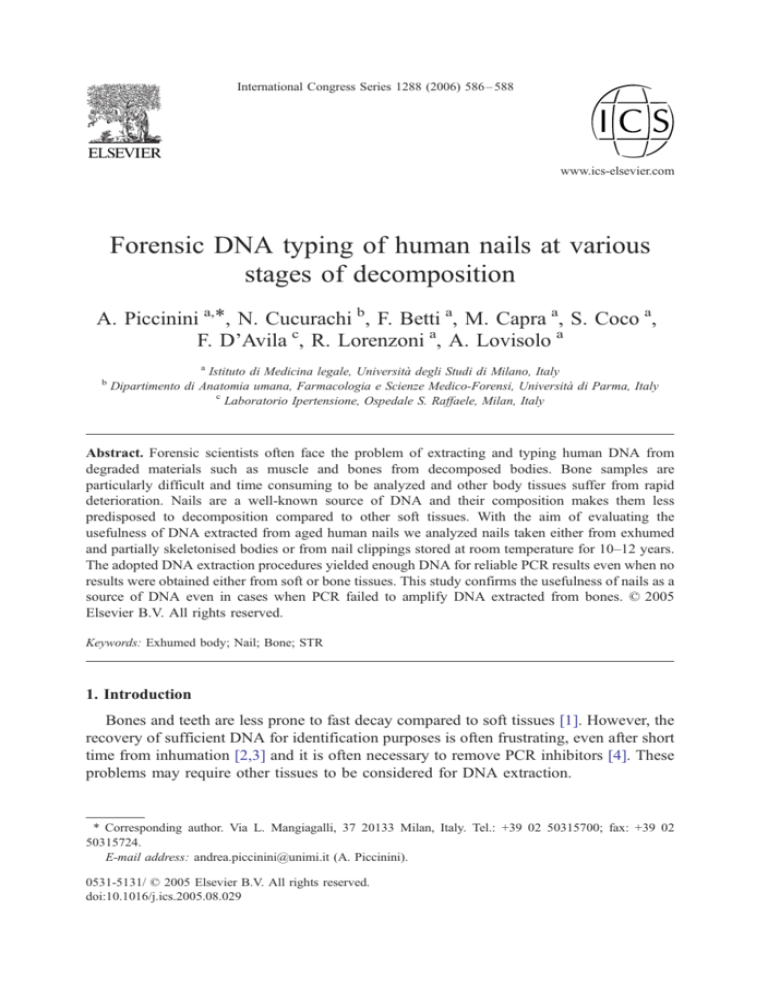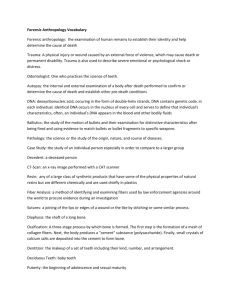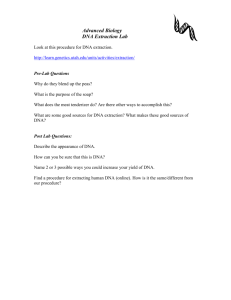
International Congress Series 1288 (2006) 586 – 588
www.ics-elsevier.com
Forensic DNA typing of human nails at various
stages of decomposition
A. Piccinini a,*, N. Cucurachi b, F. Betti a, M. Capra a, S. Coco a,
F. D’Avila c, R. Lorenzoni a, A. Lovisolo a
b
a
Istituto di Medicina legale, Università degli Studi di Milano, Italy
Dipartimento di Anatomia umana, Farmacologia e Scienze Medico-Forensi, Università di Parma, Italy
c
Laboratorio Ipertensione, Ospedale S. Raffaele, Milan, Italy
Abstract. Forensic scientists often face the problem of extracting and typing human DNA from
degraded materials such as muscle and bones from decomposed bodies. Bone samples are
particularly difficult and time consuming to be analyzed and other body tissues suffer from rapid
deterioration. Nails are a well-known source of DNA and their composition makes them less
predisposed to decomposition compared to other soft tissues. With the aim of evaluating the
usefulness of DNA extracted from aged human nails we analyzed nails taken either from exhumed
and partially skeletonised bodies or from nail clippings stored at room temperature for 10–12 years.
The adopted DNA extraction procedures yielded enough DNA for reliable PCR results even when no
results were obtained either from soft or bone tissues. This study confirms the usefulness of nails as a
source of DNA even in cases when PCR failed to amplify DNA extracted from bones. D 2005
Elsevier B.V. All rights reserved.
Keywords: Exhumed body; Nail; Bone; STR
1. Introduction
Bones and teeth are less prone to fast decay compared to soft tissues [1]. However, the
recovery of sufficient DNA for identification purposes is often frustrating, even after short
time from inhumation [2,3] and it is often necessary to remove PCR inhibitors [4]. These
problems may require other tissues to be considered for DNA extraction.
* Corresponding author. Via L. Mangiagalli, 37 20133 Milan, Italy. Tel.: +39 02 50315700; fax: +39 02
50315724.
E-mail address: andrea.piccinini@unimi.it (A. Piccinini).
0531-5131/ D 2005 Elsevier B.V. All rights reserved.
doi:10.1016/j.ics.2005.08.029
A. Piccinini et al. / International Congress Series 1288 (2006) 586–588
587
Despite nails have proven to be suitable for analysis (e.g. [5–7]), their use as a source of
DNA in the forensic field is rather uncommon. In this study we evaluated the usefulness of
DNA extracted from aged human nails collected from partially skeletonised bodies and
from nail clippings stored at room temperature for 10–12 years.
2. Materials and methods
Samples: 4 human bone samples buried for 6, 7, 17 and 48 years respectively (forensic paternity
cases); 5 nail samples buried for 2, 7, 8, 10 and 15 years respectively (forensic paternity cases). Only
in 1 case nails and bone came from the same individual (7-year-old sample). A medical genetics
laboratory entrusted us with the DNA extraction from 10 nail clippings stored at room temperature
for 10–12 years which represented the only remains of deceased patients. Prior to DNA extraction all
the instruments used had been thoroughly cleaned into a 10% acetic acid solution. The outer
diaphyseal surface of femur bones was discarded and the compact bone (5 g/bone) was scraped and
pulverised into liquid nitrogen. The protocol suggested by Hochmeister et al. [8] was followed with
minor modifications for 3 out of 4 bone samples with DNA concentration using commercial devices.
DNA from the remaining bone sample, as well as for 2 bone samples for which the organic protocol
gave no or poor PCR results, was extracted using commercial kits (QIAamp DNA Mini and/or Maxi
kit, Qiagen, 5 g bone powder for each sample). Each nail clipping and approximately half of one nail
from each exhumed body were minced using a sterile scalpel. The fragments were incubated in
digestion buffer (200 mM sodium acetate, 0.5% SDS, 2 mg/ml Proteinase K, 100 mM DTT—final
volumes) at 56 8C up to 2 days with repeated additions of fresh Proteinase K. DNA was always
purified using the phenol–chloroform method, resuspended in 30–50 Al and amplified using
commercial kits (AmpflSTR Profiler, AmpflSTR SGM Plus, Applied Biosystems; Powerplex16,
Promega) in a final volume of 15 Al, 30 cycles. Fragments were resolved on an ABI 310 Genetic
Analyzer with either automatic (Genotyper) or manual allele call. Statistical analyses with Italianspecific frequency data [9] were carried out in forensic cases by calculating paternity index (PI) and
probability of paternity (W). Extraction and amplification negative controls were always carried out.
3. Results
For one bone only (17 years old) the phenol–chloroform extraction method yielded DNA for
successful amplification, whilst this procedure gave good results for all the 15 nails examined.
Commercial kits proved effective for bones aged 48 and 6 years old after failure of the organic
procedure. No results were obtained for the bone sample aged 7 years old with either methods,
whereas the correspondent nail sample gave good results. Allelic drop-out for HMW loci and/or peak
imbalance was occasionally observed. Negative controls always gave negative results.
4. Discussion
In our routine we observed an increasing demand for paternity testing when the putative
father is deceased, when the only option is the exhumation of the body. When soft tissues
are badly decomposed, bones and teeth are usually considered the tissues of choice for
extracting DNA. It is well known, however, that environmental condition may influence
the degree of DNA decay within bones and teeth even fairly shortly after burial, thus
leading to unsuccessful amplifications [2,3].
588
A. Piccinini et al. / International Congress Series 1288 (2006) 586–588
In this study we report the results of 8 forensic paternity cases on exhumed bodies, for 4
of which bone samples were analyzed. The phenol–chloroform method yielded too little
amount of DNA in 3 out of these 4 cases. Commercial extraction kits were therefore used
and proved to be effective in all but one bone sample (7-year-old sample). In this case
DNA was extracted from nail samples which had been collected after exhumation. The
derived STR profile matched the one of the living putative son at each of the 15 loci
investigated (PI N 100,000; W N 99.999%). Even high molecular weight loci (e.g.
D2S1338) gave good results.
In each of the following 4 cases investigated, DNA was extracted from nails only and
the STR profiles matched those of the putative living sons/daughters, thus confirming the
reliability of the method used. Penta D and PentaE alleles were also positively typed.
The extracted DNA from nail clippings stored at room temperature for 10–12 years
gave good amplification results both using forensic kits and in the clinical setting which
the DNA was extracted for (molecular diagnosis of genetic diseases).
This study thus confirms that nails are a suitable source of DNA, even after long time of
inhumation. The DNA extraction procedure is less tedious and less time consuming than
bone DNA extraction.
It is likely that the preservation of DNA in nails may be due to a positive
microenvironment surrounding the hands after burial: in our tradition the hands of a
deceased are cross-positioned onto the abdomen, above the corpse, with no or little contact
with other putrefying tissues. We therefore suggest to collect fingernails in all cases when
these tissues are available.
References
[1]
[2]
[3]
[4]
[5]
[6]
[7]
[8]
[9]
William D. Haglund, Marcella H. Sorg (Eds), 1997, CRC Press Publisher.
C. Cattaneo, et al., J. For. Sci. 42 (1997) 1126 – 1135.
C.J. Kolman, N. Tuross, Am. J. Phys. Anthropol. 111 (2000) 5 – 23.
C. Hänni, et al., Nucleic Acids Res. 23 (1995) 881 – 882.
M.A. Tahir, N. Watson, J. For. Sci. 40 (1995) 634 – 636.
T.D. Anderson, et al., J. For. Sci. 44 (1999) 1036 – 1053.
M.A. Tahir, et al., J. For. Sci. 45 (2000) 902 – 907.
M.N. Hochmeister, et al., J. For. Sci. 36 (1991) 1649 – 1661.
http://www.gefi-forensicdna.it.







